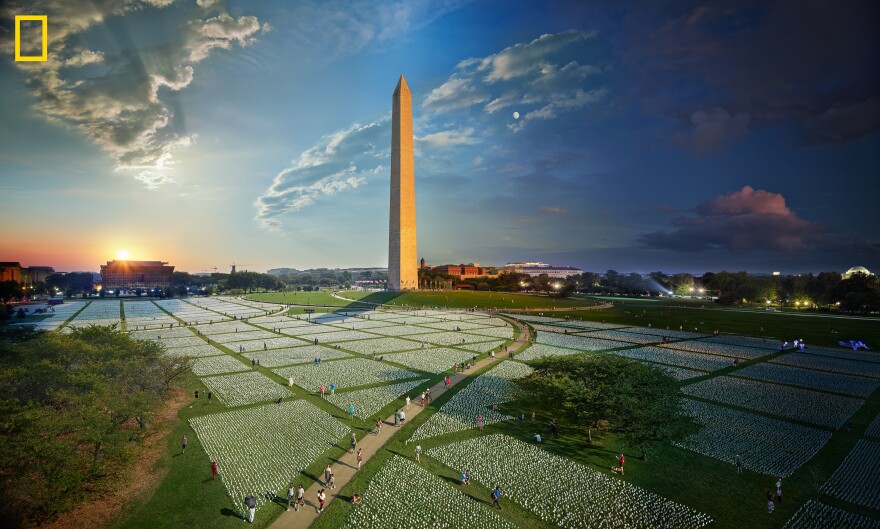On September 18th and 19th, National Geographic Explorer Stephen Wilkes spent 30 consecutive hours on a lift at 45 feet in the air photographing a public installation on the National Mall, In America: Remember.
This installation by Suzanne Firstenberg comprises 670,000 white flags, each representing a life lost to COVID-19. Over the weekend, the U.S. breached the threshold of 700,000 lives lost. Wilkes implemented his renowned Day to Night photographing style in order to capture this image. This involved taking 4,882 photos over the course of 30 hours and blending them together for this final product. NPR spoke to Wilkes about the project.
Could you walk me through your process in capturing this photo?
I had no idea of what the scale of this was going to be. I made a trip down to D.C. and met Suzanne and was able to get a sense of where she was thinking about doing this. I remember walking the grounds with my editor Kathy Moran and getting a sense of like, "OK, how do you view something the scale of this?"
There's going to be thousands upon thousands of flags. I started to think about the picture initially as having time change as the flags are being moved and planted. But I quickly realized that this picture was going to be most powerful when the exhibit was completed, seeing the rows and rows and rows of flags that had been planted. I knew at that point that I needed to get above it.
I also knew that I really wanted the National Museum of African American History and Culture as an anchor in the photograph. When you see what's happened to people of color with this virus ... They have been so incredibly affected by it in a really disproportionate way. I wanted to have that as the left side of the image and this time of year, the sun would be rising over that building.
That's how I begin my journey. You find a starting point and then you find the endpoint and then the middle of the story really becomes where my focus goes. I knew I wanted to be up in the air, and I wanted to use this beauty pathway that brings you into the scene. There'd be an ebb and flow of all the different people who would be coming to experience this exhibit.
What really surprised me was when I got up above, I was able to see these beautiful benches that Suzanne had included for people to sit down and take moments to reflect. All of those elements came together as a picture as I physically got up in the air and I began to see the scene for the first time in my eyes.
What was so powerful about what Suzanne had created, and what I hope to convey in this photograph, is the scale and the magnitude of the loss. But when you begin to walk through this exhibit and realize that each flag represents a family member, it's powerful. To see a loved one reflect on that person they lost on that flag is very moving. Watching it from above was as if I was watching the nation collectively grieve.
Everybody could say, "It's such a dark, devastating scene," when you really think about what it's representing. I wanted to create a photograph that had those elements of that narrative storywise, but also was a photograph about hope and coming together. That's one of the beautiful things that the installation naturally does. Thousands of people come out and connect in a way and can reflect on our collective loss.
What kind of emotions were you intending to evoke with this photo?
There's a power in beauty. When I show you something beautiful, it allows me access into your soul for a second. If I show you something dark and depressing, you're going to turn the page, swipe up or whatever you're going to do. You're not going to be present enough to allow me that moment of entry into your emotional center of your heart. When I can create something that's beautiful and the criticism is almost a sense of awe when people look at it, they will take more time to go into it.
You think about all religions and there's always this connection between light and darkness, living and death. I wanted to create this in a way where I feel like there's a new day — the sun coming up over on the left side of the photograph and then being able to watch and see the grand unfolding of these flags as your eye moves across it. You get caught up in the visuals and the power of the light and the graphics.
But as you look at the photograph, these individual moments that I captured of people reflecting, kneeling, reading, doing things and all of those little moments is what I hope people would have an emotional connection to – that you'd stay in it long enough to have that experience, that it would move you.
These are the kinds of things we need to bear witness to. People really need to be able to mourn and comprehend what is happening and I think we've all been in shock, but now is a moment where we need to start to reflect and understand what's happening. These are the kinds of things that allow us to do that.
Is there anything you want people to take away from this image?
I think this is the moment that we need to come together. The virus doesn't care who you voted for. It doesn't care what political side of the spectrum you're on, doesn't care if you're Black, white, Hispanic, a guy or a girl. It doesn't care about any of that.
Copyright 2024 NPR. To see more, visit https://www.npr.org.




